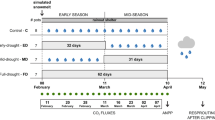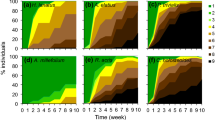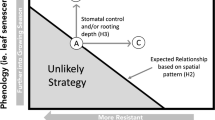Abstract
A very high percentage (around 70%) of the agronomic area in Switzerland is covered by grasslands at various altitudes where environmental conditions, management, community structure and productivity vary widely. As heat waves and drought are predicted to increase in future climate, survival of plant species in grasslands is a major issue of concern in Central Europe. The effect of summer drought on representative grasslands in Switzerland was studied through drought experiments (using rain-out shelters avoiding natural precipitation) to understand the response of predominant species to changed climatic conditions. The physiological performance (gas exchange, leaf water potential) of selected species was investigated at three locations in Switzerland. The pre-dawn leaf water potential of all species was lower (more negative) under the dryer conditions at the three sites. Net photosynthesis and stomatal conductance of forb and legume species did not show major changes under drought, while grass species showed large decreases at the lowland site. These differences between forb-legume and grass species were not observed at the pre-alpine and alpine site. The apparent drought tolerance of the forb-legume species seems to be due—at least partially—to increased water use efficiency under drought conditions.





Similar content being viewed by others
References
Aranda I, Gil L, Pardos JA (2005) Seasonal changes in apparent hydraulic conductance and their implications for water use of European beech (Fagus sylvatica L.) and sessile oak Quercus petraea (Matt.) Liebl in South Europe. Plant Ecol 179:155–167
Begert M, Seiz G, Schlegel T, Musa M, Baudraz G, Moesch M (2003) Homogenisierung von Klimamessreihen der Schweiz und Bestimmung der Normwerte 1961–1990: Schlussbericht des Projekts NORM90. Veroff. MeteoSchweiz 67:1–170
Brink GE, Pederson GA (1998) White clover response to a water-application gradient. Crop Sci 38:771–775
Cai ZQ, Chen YJ, Guo YH, Cao KF (2005) Responses of two field-grown coffee species to drought and re-hydration. Photosynthetica 43:187–193
Cao MK, Woodward FI (1998) Net primary and ecosystem production and carbon stocks of terrestrial ecosystems and their responses to climate change. Glob Change Biol 4:185–198
Chaves MM, Maroco JP, Pereira JS (2003) Understanding plant responses to drought—from genes to the whole plant. Funct Plant Biol 30:239–264
Ciais P, Reichstein M, Viovy N, Granier A, Ogee J, Allard V, Aubinet M, Buchmann N, Bernhofer C, Carrara A, Chevallier F, De Noblet N, Friend AD, Friedlingstein P, Grunwald T, Heinesch B, Keronen P, Knohl A, Krinner G, Loustau D, Manca G, Matteucci G, Miglietta F, Ourcival JM, Papale D, Pilegaard K, Rambal S, Seufert G, Soussana JF, Sanz MJ, Schulze ED, Vesala T, Valentini R (2005) Europe-wide reduction in primary productivity caused by the heat and drought in 2003. Nature 437:529–533
Day KJ, John EA, Hutchings MJ (2003) The effects of spatially heterogeneous nutrient supply on yield, intensity of competition and root placement patterns in Briza media and Festuca ovina. Funct Ecol 17:454–463
Easterling DR, Meehl GA, Parmesan C, Changnon SA, Karl TR, Mearns LO (2000) Climate extremes: observations, modeling, and impacts. Science 289:2068–2074
Flexas J, Bota J, Galmes J, Medrano H, Ribas-Carbo M (2006) Keeping a positive carbon balance under adverse conditions: responses of photosynthesis and respiration to water stress. Physiol Plantarum 127:343–352
Frei C, Scholl R, Fukutome S, Schmidli R, Vidale PL (2006) Future change of precipitation extremes in Europe: intercomparison of scenarios from regional climate models. J Geophys Res Atmos 111:D06105
Gallé A, Feller U (2007) Changes of photosynthetic traits in beech saplings (Fagus sylvatica) under severe drought stress and during recovery. Physiol Plant 131:412–421
Gilgen AK, Buchman N (2009) Responses of temperate grasslands at different altitudes to simulated summer drought differed but scaled with annual precipitation. Biogeosciences 6:2525–2539
Gilgen AK, Signarbieux C, Feller U, Buchmann N (2010) Competitive advantage of Rumex obtusifolius L. might increase in intensively managed temperate grasslands under drier climate. Agric Ecosyst Environ 135:15–23
Grieu P, Lucero DW, Ardiani R, Ehleringer JR (2001) The mean depth of soil water uptake by two temperate grassland species over time subjected to mild soil water deficit and competitive association. Plant Soil 230:197–209
Guckert A, Robin C, Grieu P, Gras F (1993) Influence du déficit hydrique sur le trèfle blanc. Fourrages 135:369–381
Guobin L, Kemp DR (1992) Water stress affects the productivity, growth components, competitiveness and water relations of Phalaris and white clover growing in mixed pasture. Aust J Agric Res 43:659–672
Hiller R, Zeeman MJ, Eugster W (2008) Eddy-covariance flux measurements in the complex terrain of an alpine valley in Switzerland. Bound Lay Meteorol 127:449–467
Houghton J (1995) The roles of carbon-dioxide and water-vapor in warming and cooling the Earths troposphere—comment. Spectrochim Acta A 51:1391–1392
Iijima M, Morita S, Zegada-Lizarazu W, Izumi Y (2007) No-tillage enhanced the dependence on surface irrigation water in wheat and soybean. Plant Prod Sci 10:182–188
Johns GG, Lazenby A (1973) Defoliation, leaf area index, and water use of 4 temperate pasture species under irrigated and dryland conditions. Aust J Agric Res 24:483–795
Kahmen A, Perner J, Buchmann N (2005) Diversity-dependent productivity in semi-natural grasslands following climate perturbations. Funct Ecol 19:594–601
Karatassiou M, Noitsakis B, Koukoura Z (2009) Drought adaptation ecophysiological mechanisms of two annual legumes on semi-arid Mediterranean grassland. Sci Res Essays 4:493–500
Kerr RA (2001) Climate change—it’s official: humans are behind most of global warming. Science 291:566–566
Kirschbaum MUF (1988) Recovery of photosynthesis from water-stress in Eucalyptus pauciflora. A process in 2 stages. Plant Cell Environ 11:685–694
Kutschera L, Lichtenegger E, Sobotik M (1992) Wurzelatlas mitteleuropäischer Grünlandpflanzen. Gustav Fischer, Stuttgart
Liste HH, White JC (2008) Plant hydraulic lift of soil water—implications for crop production and land restoration. Plant Soil 313:1–17
Meehl GA, Tebaldi C (2004) More intense, more frequent, and longer lasting heat waves in the 21st century. Science 305:994–997
Meehl GA, Washington WM, Arblaster JM, Bettge TW, Strand WG (2000) Anthropogenic forcing and decadal climate variability in sensitivity experiments of twentieth- and twenty-first-century climate. J Clim 13:3728–3744
Osmond CB, Austin MP, Berry JA, Billings WD, Boyer JS, Dacey JWH, Nobel PS, Smith SD, Winner WE (1987) Stress physiology and the distribution of plants. Bioscience 37:38–48
Pino J, Haggar RJ, Sans FX, Masalles RM, Hamilton RNS (1995) Clonal growth and fragment regeneration of Rumex obtusifolius L. Weed Res 35:141–148
Roth K (2006) Bodenkartierung und GIS-basierte Kohlenstoffinventur von Graslandböden: Untersuchungen an den ETH-Forschungsstationen Chamau und Früebüel (ZG, Schweiz). Diploma thesis, University of Zurich, Switzerland
Saidi A, Ookawa T, Motobayashi T, Hirasawa T (2008) Effects of soil moisture conditions before heading on growth of wheat plants under drought conditions in the ripening stage: insufficient soil moisture conditions before heading render wheat plants more resistant to drought during ripening. Plant Prod Sci 11:403–414
Schär C, Vidale PL, Lüthi D, Frei C, Häberli C, Liniger MA, Appenzeller C (2004) The role of increasing temperature variability in European summer heatwaves. Nature 427:332–336
Seneviratne SI, Lüthi D, Litschi M, Schär C (2006) Land-atmosphere coupling and climate change in Europe. Nature 443:205–209
Skinner RH (2008) Yield, root growth, and soil water content in drought-stressed pasture mixtures containing chicory. Crop Sci 48:380–388
Solomon AM, Kirilenko AP (1997) Climate change and terrestrial biomass: what if trees do not migrate!. Global Ecol Biogeogr 6:139–148
Stampfli A, Zeiter M (2004) Plant regeneration directs changes in grassland composition after extreme drought: a 13-year study in southern Switzerland. J Ecol 92:568–576
Thomas H (1984) Effects of drought on growth and competitive ability of perennial ryegrass and white clover. J Appl Ecol 21:591–602
Whitehead DC (1983) The influence of frequent defoliation and of drought on nitrogen and sulfur in the roots of perennial ryegrass and white clover. Ann Bot Lond 52:931–934
Zaller JG (2007) Effect of patchy distribution of soil nutrients on root morphology and biomass allocation of selected grassland species: experimental approach. Pol J Ecol 55:731–747
Zavalla MA (2004) Integration of drought tolerance mechanisms in Mediterranean sclerophylls: a functional interpretation of leaf gas exchange simulators. Ecol Model 176:211–226
Zegada-Lizarazu W, Iijima M (2005) Deep root water uptake ability and water use efficiency of pearl millet in comparison to other millet species. Plant Prod Sci 8:454–460
Zegada-Lizarazu W, Izumi Y, Iijima M (2006) Water competition of intercropped pearl millet with cowpea under drought and soil compaction stresses. Plant Prod Sci 9:123–132
Acknowledgments
The authors thank Marco Schnider, Barbara Gerber and Gaëlle Mongelard for their help in the field, Anna Katarina Gilgen for the very nice collaboration in setting up the drought experiment and Christina Reynolds-Henne for her support in improving the English of the manuscript. We also thank Sylvain Delzon (University of Bordeaux I) who offered his helpful assistance for the statistical analysis on the physiological measurements. The authors are grateful to Matthias J. Zeeman (ETH Zurich) for sharing his precipitation data. This work was part of the project “PLANT/SOIL” within the “NCCR Climate”, a cooperative research program supported by the Swiss National Science Foundation.
Author information
Authors and Affiliations
Corresponding author
Rights and permissions
About this article
Cite this article
Signarbieux, C., Feller, U. Effects of an extended drought period on physiological properties of grassland species in the field. J Plant Res 125, 251–261 (2012). https://doi.org/10.1007/s10265-011-0427-9
Received:
Accepted:
Published:
Issue Date:
DOI: https://doi.org/10.1007/s10265-011-0427-9




